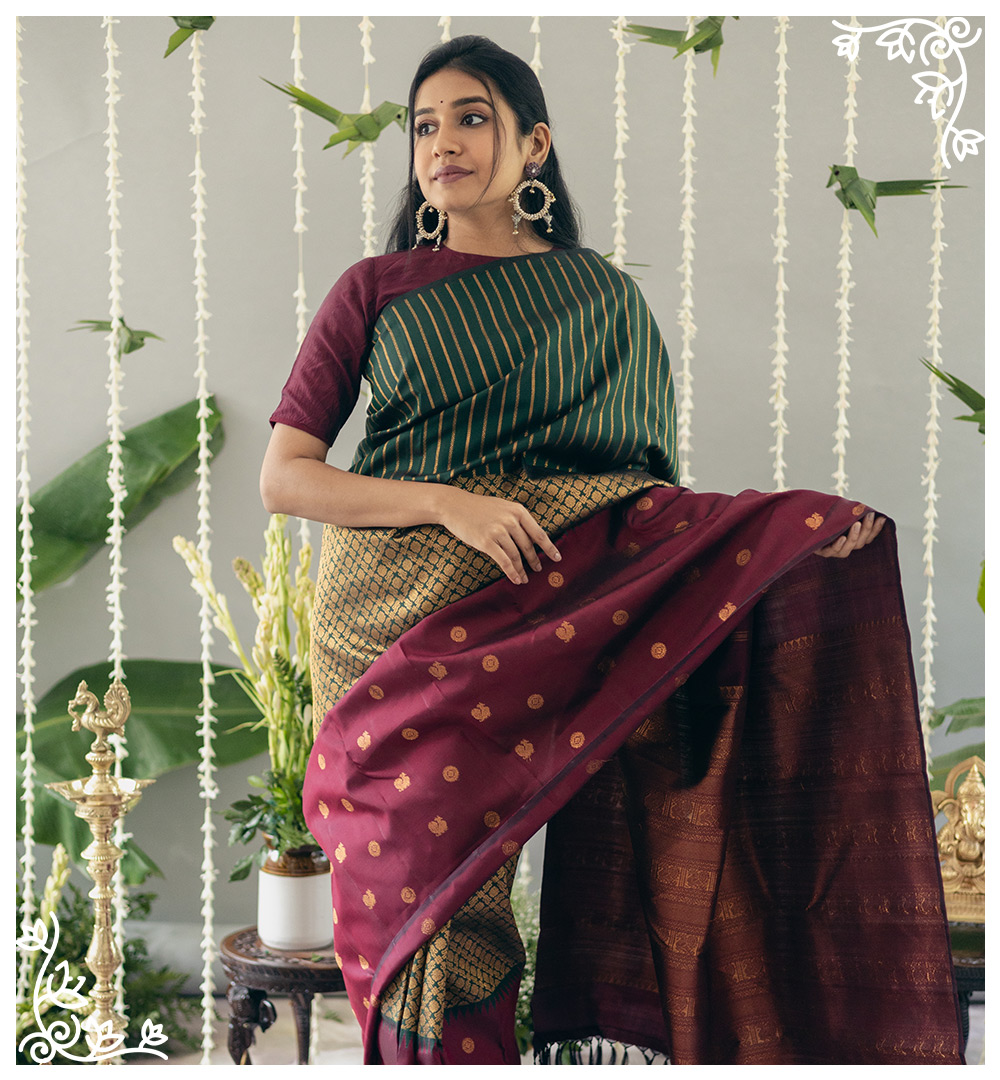Flower Power: Top 5 Floral Motifs for Kanchipuram Sarees
Significance of Flowers for the Indian Women
Flowers are the most beautiful of God’s creations and the best gifts bestowed upon us by Mother Nature. The sight of flowers in full bloom fills our minds with hope and hearts with joy. And it also gently reminds us to fill our days and lives, however short or long they may be, with purpose and love. And for the Indian woman, the love for flowers is a whole different ball game; she uses flower strings to embellish her braided hair, decorates her home with flowers arranged in a rustic earthen or metal urli; offers flower garlands to the deities in her puja and ultimately to look like an apsara, she drapes herself in a Kanchipuram Saree bedecked with the floral motifs.
Thaamarai
The sight of the Lotus, an aquatic perennial in divine pink and white hues, sets our hearts aflutter. It is a majestic-looking flower blooming in teeming numbers in marshy ponds with its bright green leaves fanning out beautifully. As a symbol of purity, resilience, and rebirth, the lotus symbol is a favourite motif in India in the arenas of art, culture, textiles, religion, and spirituality. An ‘Arakku’ (maroon) or ‘Vadaamalli’ (purple) coloured Kanchipuram silk saree with golden zari lotus motifs is certainly a cynosure to the eyes. Lotus motifs can also adorn the borders and pallu in a double pettu (row) design of brightly coloured Kanchi Silk Sarees.
Uthiri Poo (Stalked-out Flowers)
The Vana Singaram (beauty of the forest) saree is a classic example of the unique status of the richness of Indian textile design. The beautiful flora and fauna inhabiting a verdant, lush forest are portrayed very aesthetically with zari thread detailing on a radiant Kanchipuram saree. The motifs could be uthiri poo (stalked-out flowers) or thotti poo (a flower bouquet in a vase) decorating the length and breadth of the saree, making it a magnificent visual masterpiece. The Vana Singaram saree looks so very royal and grand that any bride would lovingly covet it for her wedding trousseau.
Malligal Poo (Jasmine), Sembaruthi and Thazham Poo
The fragrant jasmine with its enchanting white petals and alluring green stalk figures is an attractive motif in Kanchipuram sarees. The bulbous jasmine bud with a slender stalk looks fabulous if it is set in zari thread on a dark or pastel-shaded kanchi silk saree. A bottle green or pistachio green silk saree with golden or silver zari-worked Malligai Mottu (jasmine buds) is undoubtedly a stealer of hearts.
The hibiscus or Sembaruthi Poo motif also looks marvellous when set in a brocade pattern on a Kanchi silk saree. Also If it is painted along with its leaves in a creeper-like design it enhances the look of the saree to that of a timeless beauty.
The Thazhampoo or screw pine flower is a deliciously fragrant flower which is also widely used as a motif in silk sarees. The Thazhampoo border motif looks amazingly beautiful in silk sarees with contrasting body border colours.
Rudraksham (Bead Tree)
The Rudraksha, meaning the eyes of Shiva is considered to be a very auspicious bead encased in its immense creative, medicinal, and spiritual powers. Puranic lore says that Shiva's tears of ecstasy during his meditation (after the annihilation of the demon Tripurasura) fell to the earth and germinated as the Rudraksha tree. So as a motif, the Rudraksha is captured by the warp and weft of the weavers’ loom, onto the silky weave of the Kanchipuram saree perfectly. At a cursory glance, it looks geometric in shape but a close look would reveal its intricate detailing. The rudraksha motif works well as an individual design on the body or as a single/double pettu on the contrast-coloured border of a Kanchi silk saree.
Rose
The ‘Rose’ is indubitably a thing of beauty and joy forever. Hailing from the flowering plant family of ‘ Rosaceae’ the rose plant is found in a wide variety of habitats and hence its global appeal. The rose flower is a strong symbol of love, passion, and energy and has made its way as a motif into fabrics from ancient times in all cultures and civilizations. Carrying a magical fragrance, the rose flowers are a vision of beauty, blooming in a burst of colours ranging from pastel pink, peach, and white to a spirited and vibrant yellow, orange, and red. A Kanchipuram silk saree embossed with gold zari rose motifs in the body, borders, and pallu is a labour of love for the master weaver and a piece de resistance for the buyer who comes scouting for a masterpiece saree.
You are welcome to Tulsi Madras to have a look at the visual treat of Kanchipuram silk sarees with floral motifs. Choose between the lemon yellow Kanchipuram silk with fine floral prints all over and the pastel blue-yellow bordered Kanchipuram with beautiful blossoms ornamenting the body, border pallu and so many other beauties which will hold you enthralled.



